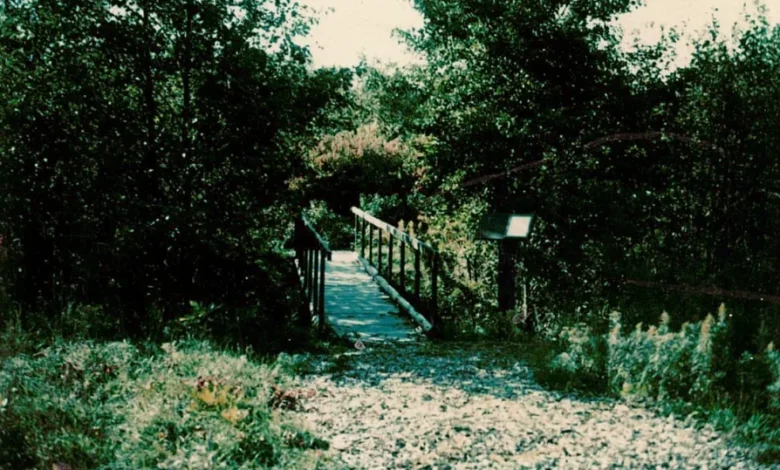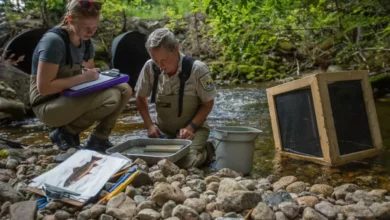Shifting Baselines: Environmental Change at Hamlin Beach State Park


 At the western edge of Hamlin Beach State Park on the shore of Lake Ontario, beyond a row of trees, is Yanty Marsh Trail. The trail loops through a deciduous (broadleaf) forest along the lake, pausing to overlook a large marsh and winding beneath the canopy of a white pine grove.
At the western edge of Hamlin Beach State Park on the shore of Lake Ontario, beyond a row of trees, is Yanty Marsh Trail. The trail loops through a deciduous (broadleaf) forest along the lake, pausing to overlook a large marsh and winding beneath the canopy of a white pine grove.
In the fall, beech leaves paint the sky in their wistful yellow hues as the birdsongs of spring and summer slowly grow fainter. Chipmunks gather their last nuts for the winter and the mystical great blue heron observes overhead. The white pines stand stoic among the falling leaves.
As chilly mornings and early sunsets lure the marsh into slumber, the world stalls. The 65 acres of Yanty Marsh are released from the sweltering days of summer, the balance of the seasons returning.
A hundred years ago, this scene looked different. With each freeze and thaw of the marsh, the stories of its past fade alongside time. An area once deforested and at risk of disappearing, the marsh and surrounding land have transformed over the past hundred years into the deciduous trail and marsh so many enjoy today.
From former farmland to forests and beaches, the park’s shifting landscapes have shaped the experiences of each generation of park-goers. We tend to understand these changes as occurring within our lifetimes, rather than focusing on the total changes that have occurred over many generations.
As time goes on, collective memory of the park’s past becomes altered or diminished. This concept, known to ecologists as “shifting baselines,” serves as a lens through which we can ponder the changes within Yanty Marsh, placing its history within the greater context of the natural world.
The stories of Yanty’s past enrich and guide our understanding of nature as we walk along the nearly mile-long trail.
Shifting Baselines
The term “shifting baselines” refers to how perceptions of nature change from generation to generation. Each generation grows up with its own concept of the natural world, comparing changing environmental conditions to a baseline formed within their lifetimes.
Yet the full picture is larger. Environmental change occurs over tens or hundreds of years. Using one’s own experiences to gauge environmental change limits understanding of this change.
For example, younger generations may only be familiar with the decline of a certain tree species within their lifetimes and underestimate the total loss of the tree species over many previous generations.
A forest may seem abundant with life and biodiversity, but have fewer species than it did fifty years prior. Using broader baselines helps us understand the extent to which nature has changed, providing us with a more holistic understanding of the environmental change preceding us.
While shifting baselines is usually used to describe successive generations’ acceptance of widespread environmental degradation, it can also describe how generations collectively forget environmental progress.

 A hiker visiting Yanty Marsh today may view the trail’s current condition as representative of the trail throughout its history, unaware the trail’s entrance was a plowed field a little over fifty years ago.
A hiker visiting Yanty Marsh today may view the trail’s current condition as representative of the trail throughout its history, unaware the trail’s entrance was a plowed field a little over fifty years ago.
The stories of Yanty’s past contextualize the natural world around us, guiding future change and ensuring park visitors can enjoy Yanty Marsh for years to come.
As early as 1904, hunters camped on the lake shore near Yanty Marsh. Between 1935 and 1941, workers in the Civilian Conservation Corps program ice skated on the farm pond in Yanty. In the 1930s, residents petitioned for a small harbor to be built where Yanty Creek meets Lake Ontario.
In 1945, the Parks Commission and U.S. Corps of Engineers began working on plans for the harbor. These plans included a harbor and a ten-foot-wide channel. The U.S. Congress approved the project in 1968, but it was never funded. The project was abandoned in 1981. Although the harbor was never built, efforts to expand access to the area resumed in the 1970s.
In 1975, the National Audubon Society recommended a Nature Center be built within Hamlin Beach State Park. Local professors and the Park Superintendent planned an educational and accessible trail through the Yanty area as a Comprehensive Educational Training Act project.
The plans included an informational building, to be built from an old wooden bathhouse, a ramada (similar to a gazebo but square), a retaining dam, and a bridge. In 1978, park workers and volunteers got to work.
By the fall of 1978, Yanty Marsh Trail was open. An archway at the start of the trail gave way to a gravel path. The trail, equipped with interpretive signs, was used to teach ecological succession, or the gradual introduction of species in an area as it regenerates.
The trail began in an old field, now a forested area, and slowly made its way through at least seven distinct habitats: a field, shrub fields, lakeshore, a marsh, a pond, a white pine lot, and deciduous woods.
These habitats supported an abundance of wildlife. Meadowlarks and bobolinks sung in the old field. White sweet clover was a common sight along the trail. In early summer, a black tern traveled from South America to nest in the marsh.
Successional plants such as quaking aspens and staghorn sumac indicated early signs of a forest among the shrub fields. Just beyond the white pine lot, about 80 meters from the farm pond, was one of these shrub fields.
A trail guide from the era notes small conifers growing among the shrubs. The guide asks visitors to consider what the trail might look like in fifty years.
Nearly fifty years later, we reflect on these changes. The fields have mostly grown into a deciduous forest, the early successional habitats paving the way for later successional species.

 Although the interpretive signs along Yanty Trail are no longer present (you can find some remaining posts), the trail is still used for environmental education.
Although the interpretive signs along Yanty Trail are no longer present (you can find some remaining posts), the trail is still used for environmental education.
The young forest provides a habitat for migrating birds along the Lake Ontario shoreline. Sadly, the black tern no longer visits, but the marsh still thrives, home to many critters.
Educators predicted the eastern white pine lot would gradually be taken over by hardwoods whose saplings are more shade tolerant. The pines still stand tall, but hardwoods are slowly growing at their bases.
Fifty years after Yanty Trail was laid out, it continues to be a hidden treasure at Hamlin Beach State Park.
Standing under the canopy of Yanty Trail, surrounded by birdsong, it’s tempting to forget the stories that precede us. But placing these stories within the greater context of Yanty’s changes, year after year, provides insights into the intricacies of nature. If we create holistic baselines, we can more accurately consider Yanty’s past in guiding its future.
For each generation of nature lovers, birders, and explorers, Yanty Marsh has been different. The conservation efforts of past park-goers helped create Hamlin Beach State Park. In turn, actions we take today will change how future park-goers experience the park.
The next time you visit Yanty, stand on the end of the marsh boardwalk, close your eyes, and consider the many changes over the past century that have shaped Yanty Marsh. Just be prepared for a red-winged blackbird to interrupt you!
This article by New York State Genesee Region Park Naturalist Claire Devlin, first appeared on the New York State Parks & Historic Sites blog.
Illustrations, from above: The Yanty Marsh trail when it first opened; Yanty Marsh trail volunteers and the old entrance arch; and the Yanty Trail today.
Source link





